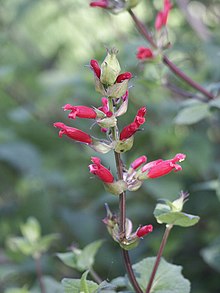Salvia sprucei is a herbaceous perennial in the Lamiaceae family that is native to Ecuador, growing at 7,000 feet (2,100 m) elevation or higher in thick scrub on steep slopes. It was named in 1898 by botanist John Isaac Briquet for the British plant collector Richard Spruce. It is likely that Spruce discovered the plant on a collecting trip in Ecuador in 1857.
Salvia candidissima is a herbaceous perennial native throughout western Greece, and parts of Turkey, Iraq, and Iran, generally between 2000 and 6500 feet elevation. Several small stems grow almost horizontally from the roots before bearing upright inflorescences. The plant reaches 3 ft in height and width in the wild. The light green leaves, 6 in long by 4 in wide, are covered with hairs on both sides and often have notches on the edges. The leaves become lighter in color as the weather gets hotter. The 8–12 inch inflorescences are branched, with 1 inch flowers in whorls that are creamy white and sometimes tipped with a yellow lip. Salvia candidissima is one of a group of seven salvias that are closely related, grow in the same habitat, and easily hybridize with each other, resulting in a great deal of variety in the species.

Salvia gesneriflora is a herbaceous perennial or subshrub native to mountainous provinces of the Sierra Madre Oriental in Mexico, growing at 7,500-10,000 ft elevation. It was named for Gesneria-like flower.The genus Gesneria is named in honor of 15th century Swiss botanist Conrad Gessner. The long tubular flowers of this salvia resemble Gesneria flowers. It is a popular ornamental plant.
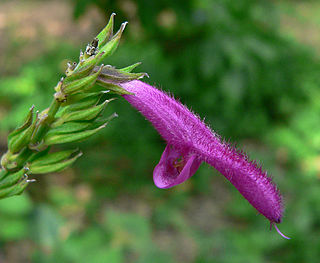
Salvia iodantha is a herbaceous perennial native to the mountains of central Mexico, growing between 2,600-10,500 ft elevation. It was described by Merritt Lyndon Fernald in 1900 and began appearing in horticulture in the 1980s.
Salvia littae is a herbaceous perennial native to the Mexican state of Oaxaca, growing at elevations of 8,000-10,000 feet. The plants typically grow in some shade in groups at the edge of moist oak forest, or cloud forest.

Salvia longispicata is a perennial shrub native to southwestern Mexico, growing between 1,000 and 6,500 feet elevation. The specific epithet "longispicata" gives the impression that the plant has "long spikes", but instead refers to the many projecting clusters of short flowering spikes that resemble small ears of corn.
Salvia merjamie is a herbaceous perennial plant that is native to the east African highlands from Ethiopia to Tanzania, and also across the Red Sea in Yemen. It grows between 6,000 and 13,000 feet elevation in grasslands, forest edges, rocky outcrops, basalt slopes, and fallow fields. The specific epithet merjamie is derived from meryamiye, the Arabian common name for the plant, which is shared with other local Salvia species such as Salvia lanigera. The Maasai common name for S. merjamie is Naingungundeu, meaning that the plant smells of rats, though the variety that is common in horticulture is named 'Mint Sauce' and is described as having a strong minty aroma. S. merjamie shares a similar distribution with Salvia nilotica, though they are not known to hybridize.
Salvia moorcroftiana is a herbaceous perennial native to the Himalayan mountains from Pakistan to western Nepal, and is especially common in the Kashmir Valley. It grows between 5,000-9,000 feet elevation on disturbed areas and open slopes. The leaves are used medicinally in Kashmir.
Salvia namaensis is an evergreen perennial shrub native to a limited area in Namibia and a wide area of South Africa. It is typically found growing on rocky slopes, shales, limestone hills, and sandy soils at 1,000 to 5,000 feet elevation. The specific epithet namaensis probably refers to the Nama tribe which is indigenous to Namaqualand, the region in Namibia where the plant grows.
Salvia napifolia is a herbaceous perennial native to Turkey and islands off its west coast, growing at elevations between sea level and 3,000 feet. Its natural habitat is maquis shrubland, rocky slopes, and disturbed roadsides. It was described by Nikolaus Joseph von Jacquin in 1773, with the specific epithet napifolia referring to the leaves being shaped like a turnip.

Salvia polystachya is a herbaceous perennial native to central Mexico and south into Guatemala and Panama, typically growing at elevations from 5,000-10,000 feet in mild climates where there is some summer rain. It is rarely seen in horticulture.

Salvia recurva is a woody-based perennial native to the cloud forests of Central America, limited to the northern slopes of Oaxaca, Chiapas, and Guatemala at elevations around 10,000 feet (3,000 m). It grows where there is year-round warmth and abundant moisture in the air and on the forest floor. Salvia recurva was described by George Bentham in 1848, with the specific epithet referring to the distinct curve in the inflorescence when it first appears.
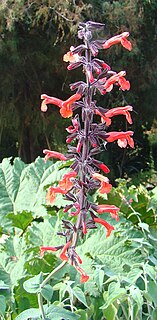
Salvia rubescens is a herbaceous perennial native to the state of Mérida in Venezuela. The University of California Botanical Garden had been growing it since 1993 from a plant collected that year in Venezuela, only identifying it as S. rubescens in 2001.
Salvia rypara is a herbaceous perennial native to Argentina and Bolivia—due to its being very adaptable it is reported to be naturalized in Mexico and possibly Central America. It prefers stream bank habitats, as the specific epithet rypara implies. It also grows in weedy thickets, thriving at elevations under 3,000 feet. Described by John Isaac Briquet in 1896, it is not very well known in horticulture, with only a few gardeners growing it since the 1990s. It is becoming more well known in the United States, France, England, and Italy because it is easy to grow and makes a very attractive garden plant.

Salvia scabra is a herbaceous perennial native to the southeastern strand of the Cape of Good Hope in South Africa, growing on sandy shores, coastal brush, and hilly slopes up to an elevation of 600 feet. It was described and named by Carl Linnaeus in 1781. The leaves and an extract from the roots have been used medicinally in its native region for at least one hundred years. Salvia scabra was introduced to California gardens around 1996, and is extremely adaptable to many types of conditions. Since then it has spread to gardens in England, France, and Italy.
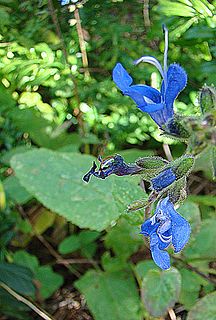
Salvia scutellarioides is an evergreen perennial native to the Andes Mountains in Ecuador, Colombia, and Peru, growing at elevations from 3,300 to 10,000 feet in mild climates where there is year-round moisture. Even though it was described by Carl Sigismund Kunth in 1817, as of 2002 it was still rarely seen in horticulture. The specific epithet is due to its similarity to Scutellaria, a genus in the mint family.
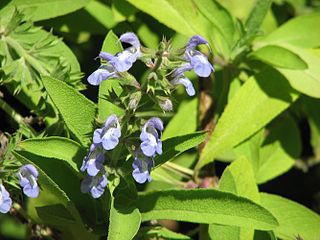
Salvia somalensis is a perennial shrub endemic to a limited range and elevation in Somalia. It grows at elevations from 4,000 feet (1,200 m) to 7,000 feet (2,100 m), typically in forest clearings or edges as a common or dominant subshrub.
Salvia staminea is a herbaceous perennial shrub native to a wide area in Asia Minor that includes Turkey, Georgia, Armenia, and Iran, where it grows at elevations from 6,000 feet (1,800 m) to 14,000 feet (4,300 m). It is typically found growing in alpine meadows, screes, and cliffs, sometimes growing with scrub oak. Due to the wide variety of habitats in which it is found, there is a wide degree of variation in the species. It was first described in 1836 and has only slowly come into use in horticulture.
Salvia taraxacifolia is a herbaceous perennial shrub that is native only to southwest Morocco, growing in the Atlas Mountains at elevations ranging from 2,000 feet (610 m) to 8,000 feet (2,400 m). Very adaptable, it grows on limestone slopes, forest clearings, and rocky riversides. It has no close allies in the genus Salvia. The specific epithet, taraxacifolia, is likely Persian in origin and means 'leaves shaped like a dandelion'.
Salvia villosa is a herbaceous perennial that is native to the Mexican states of San Luis Potosi and Coahuila, growing at approximately 4,000 feet (1,200 m) elevation in dry areas that have little or no frost.
